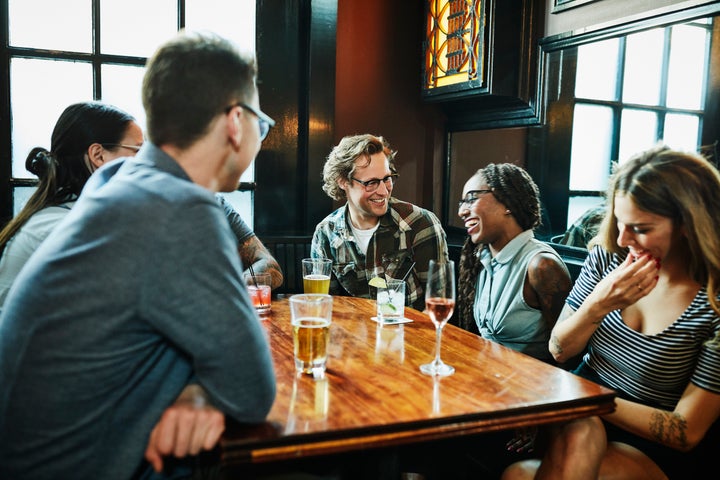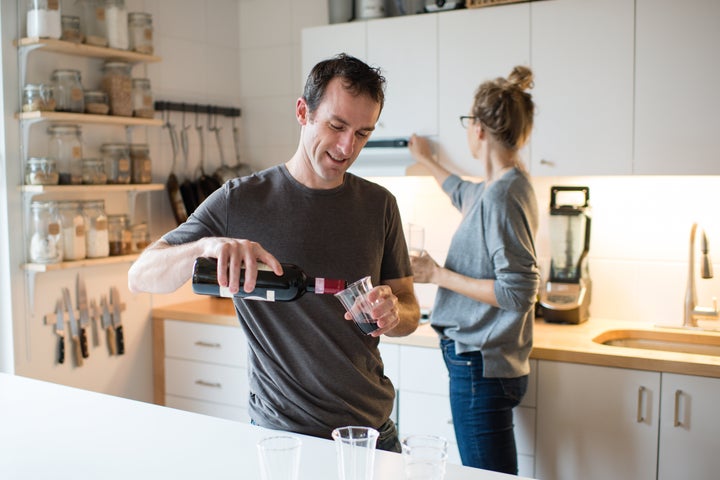If you want to drink less alcohol but don’t need to go sober, a “damp lifestyle” might be for you. Here’s how to make it happen.
Given how stressful basic survival has become, pouring yourself a drink to take the edge off is understandable. Only, maybe you’ve noticed your occasional cocktail is now a series regular. Or your hangovers aren’t as manageable on the weekends anymore.
Even though your spidey sense is telling you something has to change, you might feel like going dry — swearing off alcohol completely — is too extreme. Perhaps you’ve heard about people going “damp” instead, but what does that even mean?
Going damp, or a damp lifestyle, is a term coined by TikTok creator Hana Elson that refers to the journey of finding your imbibing sweet spot — a compromise between overuse and sobriety.
“The idea behind going damp is taking the time to recognize the role alcohol plays in your decision-making and emotional regulation and making the conscious decision to actively refrain from overuse,” Dolly Ferraiuolo, a psychotherapist based in Florida’s Tampa Bay area, told HuffPost. From short-term coping techniques to long-term lifestyle changes, thoughtful moderation of your intake is the ultimate goal.
The benefits of choosing a damp lifestyle
Depending on your individual style of drinking, the all-or-nothing rigidity of going dry might be too extreme an approach for you, to the point where your efforts backfire — especially if you don’t have the support of your social group.
“The discomfort or anxiety of being different or the feeling of being restricted or not allowed to drink could lead you to rebel and drink even more than usual,” Vanessa Kennedy, director of psychology at Driftwood Recovery in Texas, told HuffPost.
Going damp, on the other hand, may offer enough psychological flexibility for you to transform your relationship with alcohol into one of control and consistency, helping you define the triggers and pain points that trip you up and determine how best to deal with them at an organic pace, versus haphazardly oscillating between bingeing and deprivation.
The resulting physical and emotional health perks will vary: “We each have environmental, social, psychological and genetic factors that influence how we process alcohol and how it affects us,” Kennedy said.
Generally speaking, drinking in moderation can lead to lower anxiety levels, improved mental clarity and energy, better-quality sleep and improvements to any preexisting conditions you might have that can be exacerbated by alcohol, like high blood pressure or rosacea. As for the reduction in hangovers? Cherry on top.
How to know if going damp is right for you
Really, the only way to know whether you’ll jibe with a damp lifestyle is to be honest with yourself: Take an authentic inventory of whether it’s possible for you to reduce your drinking and legitimately sustain it.
“Some people report they’ve tried to go damp but can’t stick to their desired limits,” Kennedy said. “They have an underlying propensity toward addiction based on epigenetic factors — that is, the dynamic interaction between genes and environmental influences.”
Do you have a history of addiction to any substance? Do you black out repeatedly from drinking? Is it extremely difficult for you to hit the brakes when you drink? Have you experienced serious consequences as a result of alcohol use, such as relationship, legal or health problems?
If you answer yes to most or all of these questions, then going sober is likely a better fit. “Anyone who drinks heavily and/or frequently should first consult their health care provider to see if it’s safe for them to do so,” Lawrence Weinstein, chief medical officer of American Addiction Centers, told HuffPost. “Someone with even a mild alcohol use disorder could experience disruptive withdrawal symptoms after abruptly limiting their alcohol intake.” You may also want to work with a therapist to help navigate the mental health aspects of your substance use.
Did your answers all come back nay? Then it might be worth going damp. Read on for some expert-backed suggestions to kick off your journey.

1. Track your current drinking patterns
The best first step to going damp is getting to know your current drinking habits and patterns. Tracking your current habits around alcohol increases self-awareness and helps to identify any patterns that are particularly problematic.
But don’t just track what and how much you drink: “Identify the body sensations, emotions, thoughts, urges and behaviors you experience before, during and after drinking,” Maria Espinola, a licensed clinical psychologist based in Cincinnati, told HuffPost.
Do you drink to take the edge off after rough days at work? Or to avoid getting into an argument with someone? Or to relieve your social anxiety? “It’s very important to understand why you’re choosing to drink, then explore what else you can do instead to get similar results,” Espinola said.
2. Get specific with your goals
One of the biggest challenges of going damp is how individualized a process it is. Unlike going dry, which has a clear set of parameters, whether or not you’re successful at leading a damp lifestyle is highly subjective.
But this fluidity is also what gives you the opportunity to set hyperspecific goals and boundaries that suit you, therefore giving you the best odds of success. You might decide only to have a drink or two on certain days of the week, not drink by yourself, or indulge only on special occasions. Take the data you collect from tracking your drinking patterns and let your intuition guide you.
You might recognize, for instance, that you typically drink three to five alcoholic beverages when you go out with friends and this leaves you acting pretty sloppy. Going forward, you might cut back to one or two drinks as a way to still engage with your crew but monitor your behavior. “It’s an act of self-control and self-acceptance,” Ferraiuolo said.
3. Make alcohol less convenient to access
If you’re trying to break your autopilot habit of cracking open a beer after work or pouring a glass of wine before bed, don’t have it readily available — and when you do hit up the liquor store for an upcoming get-together, only buy what you need for that one outing.
The friction of having to go to the liquor store to maintain your habit automatically “forces you to decide whether or not the inconvenience is worth the added effort,” Weinstein said, acting as a handy stopgap between you and the habit you’re trying to break.
4. Take a beat before pouring
If your knee-jerk reaction is to pour a glass the second uncomfortable feelings strike, try taking a beat (say, 10 minutes) and sitting in the discomfort. Within that time frame, it’s likely the initial surge of discomfort will fade and that drink won’t feel as necessary.
“Many people choose to drink in order to escape feelings, when they may not even know how they’d deal with the situation with a sober mind,” Weinstein said. “If you give a situation time, it may not be as difficult to handle as imagined.”

5. Always have a drink in your hand
A trick that many people in recovery use in social settings is accessorizing with a glass of something nonalcoholic.
“Not having a glass in hand can make it seem like you’re drawing attention to yourself, and it’s often an invitation for someone to offer you a drink,” Weinstein said. “You might find social settings easier to navigate by carrying a drink around.” It being a nonalcoholic one is your business.
6. Spread out your intake
Little tricks can be casually utilized — starting your night with a nonalcoholic bevy, diluting each drink more than the last, downing a water between cocktails — and can help to ensure you don’t get carried away with your alcohol intake.
Another strategy that can be helpful? Finding other ways to achieve similar outcomes compelling you to drink in the first place. “If you usually choose an alcoholic beverage that warms you up and helps you feel sleepy before bed (like red wine), you could instead do a relaxation exercise and drink chamomile tea,” Espinola said.
7. Step up your mocktail game
Given how popular going damp has become, it’s no surprise the mocktail market — with both store-bought and homemade options — is more accessible and varied than ever.
“The quality of nonalcoholic drinks and beers are much better than they were in the past,” Kennedy said. By keeping nonalcoholic versions of your go-tos on standby (or indulging in the fancy-pants mocktail recipes available online), you can continue enjoying your life while keeping feelings of deprivation to a minimum.
8. Nix shots from your repertoire
“Having shots is the opposite of mindful drinking,” Espinola said. “It’s very easy to lose track of how much you’re drinking and how it’s impacting you.”
Between the high alcohol content and how much easier it is to get carried away, shots can hit a lot harder and impair how well you pace yourself the rest of the night. Swapping shots for mixed drinks gives you a visual reminder to sip smartly.
9. Keep your future self in mind
Going overboard is typically a strategy used to either extend good feelings or numb uncomfortable ones (think: wanting the euphoria of your night out to last longer or taking the edge off after an awful day at work).
It may offer relief in the moment, but the next morning? Not so much. “You might recognize this sometimes puts you in situations you’re uncomfortable with or reflect back on your behavior from the previous night with guilt and shame,” Ferraiuolo said.
The next time you’re tempted to take this route, it can be helpful to keep your future self in mind: Instead of drinking to avoid the emotional discomfort you’re feeling in the moment, decide not to drink to avoid the amplified emotional discomfort (and monster hangover) you’ll inevitably feel the next morning.
10. Put contingency plans in place
Even when you’re aware of what your triggers are and you do your best to avoid them, you might intend for your night out to go one way, only for it to take a sharp turn.
“An uncomfortable or awkward social interaction or rejection can be a particularly vulnerable time when you might want to numb your emotions with more alcohol,” Kennedy said.
This is where having a hyperspecific contingency plan in place can be helpful. “Identify a list of support people who could help you exit stage left when you feel like throwing in the towel, or record a pep talk video to your phone that your future self can watch during those tough moments,” Kennedy said. “Plan for this and you’ll likely feel better afterward about how you handled the situation.”
11. Use derailments as data
Derailments happen — and when they do, it’s important to use them as data for future growth, not to initiate a shame spiral. “Explore with curiosity, in a nonjudgmental way, what led you to drink excessively,” Espinola said. “There’s always a reason why, even if it’s not initially clear.”
Understanding why you feel and behave in a specific way takes time and practice. “The first step is to decide you want to get to know yourself better,” Espinola said. “Once you start consistently exploring what’s happening inside of you, the solutions to live a better life can become clearer.”
Credit: Source link